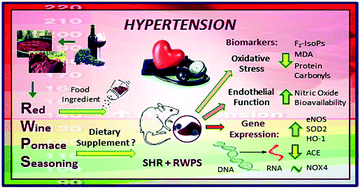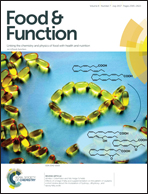Antihypertensive and antioxidant effects of supplementation with red wine pomace in spontaneously hypertensive rats
Abstract
Hypertension is associated with enhanced vascular oxidative stress and impaired endothelial function, which is related to an imbalance between reactive oxygen species and nitric oxide bioavailability. Short-term supplementation with a polyphenol-rich powdered red wine pomace seasoning (RWPS) was investigated for its effects on blood pressure and biomarkers of endothelial dysfunction and oxidative status in a model of essential hypertension. Male spontaneously hypertensive rats (SHRs) and normotensive Wistar-Kyoto rats (12-week-old, 5 rats per group) were administered RWPS (300 mg kg−1 day−1; equivalent to 7.32 mg gallic acid per kg per day) or vehicle by gavage. In SHRs, 4-week RWPS supplementation progressively decreased blood pressure, reaching 11.5% reduction at the end of the study (p < 0.001). RWPS consumption also increased the ferric reducing ability of plasma and attenuated the oxidation of plasma lipids and proteins, as evidenced by F2-isoprostanes, malondialdehyde and protein carbonyl groups as oxidative stress biomarkers. Moreover, nitric oxide production (indirectly measured) was 1.5-fold higher in SHRs + RWPS than that in SHRs (p < 0.05). These beneficial effects were partly attributed to the ability of RWPS-derived bioactive compounds to modulate aortic gene expression, with eNOS, SOD2 and HO-1 over-expression, ACE down-regulation, and no changes in NOX4. In conclusion, this study suggests the potential of red wine pomace-derived seasonings to help in the management of hypertension.



 Please wait while we load your content...
Please wait while we load your content...